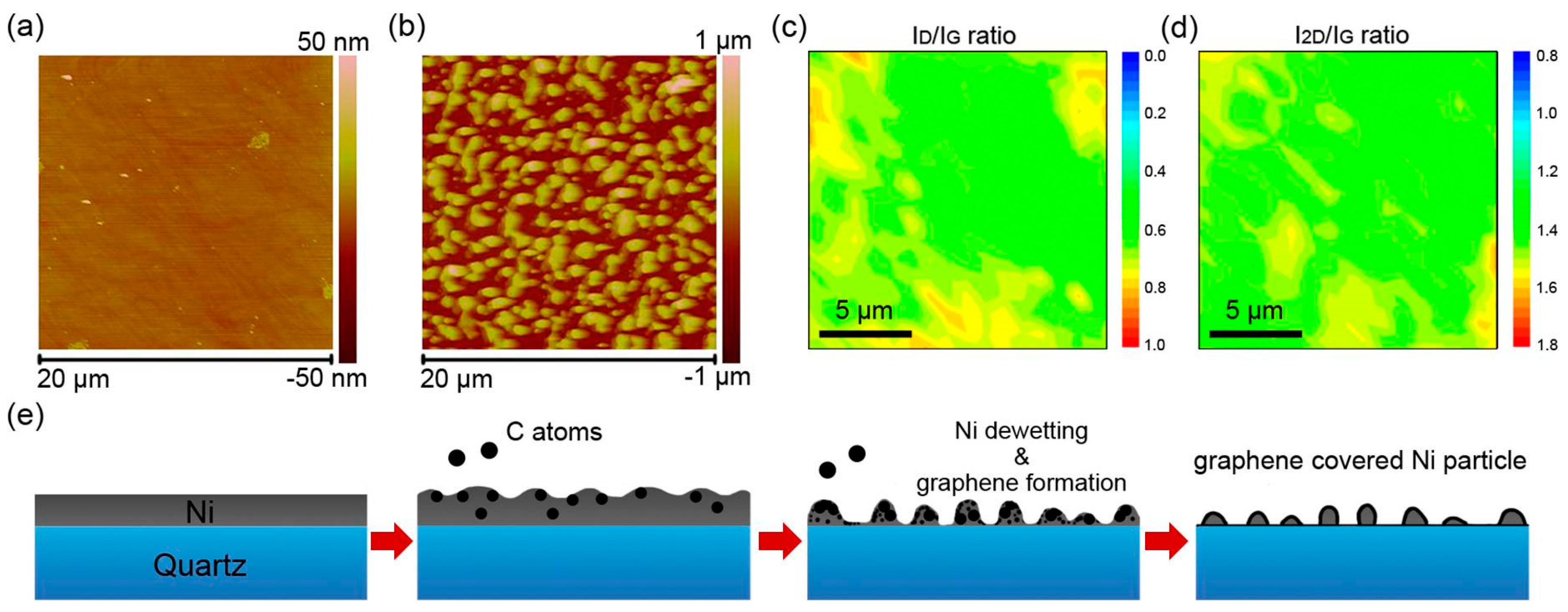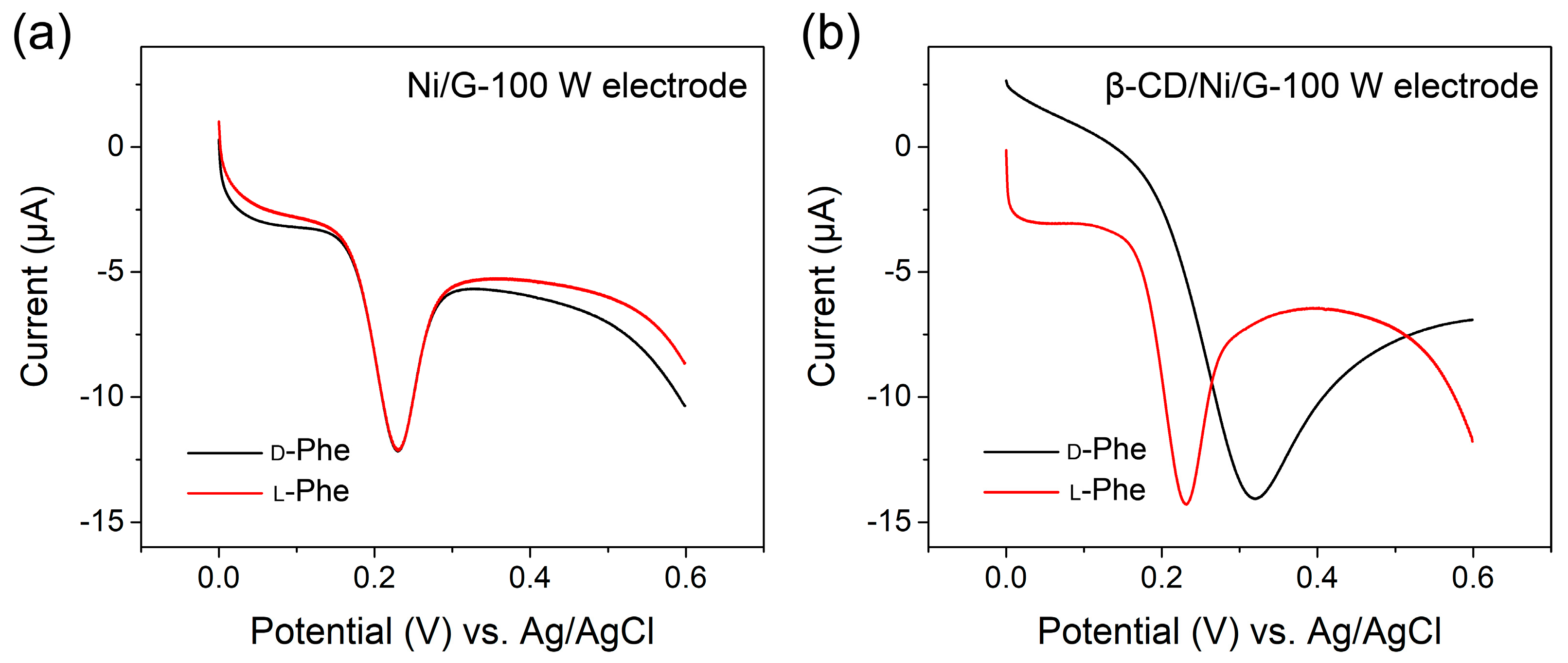β-Cyclodextrin-Immobilized Ni/Graphene Electrode for Electrochemical Enantiorecognition of Phenylalanine
Abstract
1. Introduction
2. Materials and Methods
2.1. Preparation of β-Cyclodextrin/Ni/G Electrode
2.2. Chemicals and Characterizations
2.3. Electrochemical Enantiorecognition of Phenylalanine Enantiomers
3. Results and Discussions
4. Conclusions
Supplementary Materials
Author Contributions
Funding
Acknowledgments
Conflicts of Interest
References
- Blaschke, G.; Kraft, H.; Fickentscher, K.; Köhler, F. Chromatographic separation of racemic thalidomide and teratogenic activity of its enantiomers (author’s transl). Arzneimittel-Forschung 1979, 29, 1640. [Google Scholar] [PubMed]
- Knoche, B.; Blaschke, G. Investigations on the in vitro racemization of thalidomide by high-performance liquid chromatography. J. Chromatogr. A 1994, 666, 235–240. [Google Scholar] [CrossRef]
- Chen, X.; Wang, J.; Jiao, F. Efficient enantioseparation of phenylsuccinic acid enantiomers by aqueous two-phase system-based biphasic recognition chiral extraction: Phase behaviors and distribution experiments. Process Biochem. 2015, 50, 1468–1478. [Google Scholar] [CrossRef]
- Maeda, K.; Maruta, M.; Shimomura, K.; Ikai, T.; Kanoh, S. Chiral recognition ability of an optically active poly (diphenylacetylene) as a chiral stationary phase for HPLC. Chem. Lett. 2016, 45, 1063–1065. [Google Scholar]
- Shen, J.; Li, G.; Yang, Z.; Okamoto, Y. Synthesis and chiral recognition of amylose derivatives bearing regioselective phenylcarbamate substituents at 2, 6-and 3-positions for high-performance liquid chromatography. J. Chromatogr. A 2016, 1467, 199–205. [Google Scholar] [CrossRef] [PubMed]
- Zhang, Y.; Liu, J.; Li, D.; Dai, X.; Yan, F.; Conlan, X.A.; Zhou, R.; Barrow, C.J.; He, J.; Wang, X. Self-Assembled Core-Satellite Gold Nanoparticle Networks for Ultrasensitive Detection of Chiral Molecules by Recognition Tunneling Current. ACS Nano 2016, 10, 5096–5103. [Google Scholar] [CrossRef] [PubMed]
- Zhao, W.; Wang, R.-Y.; Wei, H.; Li, J.; Ji, Y.; Jiang, X.; Wu, X.; Zhang, X. Recognition of chiral zwitterionic interactions at nanoscale interfaces by chiroplasmonic nanosensors. Phys. Chem. Chem. Phys. 2017, 19, 21401–21406. [Google Scholar] [CrossRef]
- Yang, J.; Tan, X.; Zhang, X.; Yang, Q.; Shen, Y. Cu2+ functionalized N-acetyl-l-cysteine capped CdTe quantum dots as a novel resonance Rayleigh scattering probe for the recognition of phenylalanine enantiomers. Spectrochim. Acta A 2015, 151, 591–597. [Google Scholar] [CrossRef]
- Iskierko, Z.; Checinska, A.; Sharma, P.; Golebiewska, K.; Noworyta, K.; Borowicz, P.; Fronc, K.; Bandi, V.; D’Souza, F.; Kutner, W. Molecularly imprinted polymer based extended-gate field-effect transistor chemosensors for phenylalanine enantioselective sensing. J. Mater. Chem. C 2017, 5, 969–977. [Google Scholar] [CrossRef]
- Dong, S.; Bi, Q.; Qiao, C.; Sun, Y.; Zhang, X.; Lu, X.; Zhao, L. Electrochemical sensor for discrimination tyrosine enantiomers using graphene quantum dots and β-cyclodextrins composites. Talanta 2017, 173, 94–100. [Google Scholar] [CrossRef]
- Ou, J.; Tao, Y.; Xue, J.; Kong, Y.; Dai, J.; Deng, L. Electrochemical enantiorecognition of tryptophan enantiomers based on graphene quantum dots–chitosan composite film. Electrochem. Commun. 2015, 57, 5–9. [Google Scholar] [CrossRef]
- Zaidi, S.A. Facile and efficient electrochemical enantiomer recognition of phenylalanine using β-Cyclodextrin immobilized on reduced graphene oxide. Biosens. Bioelectron. 2017, 94, 714–718. [Google Scholar] [CrossRef] [PubMed]
- Tiwari, M.P.; Prasad, A. Molecularly imprinted polymer based enantioselective sensing devices: A review. Anal. Chim. Acta. 2015, 853, 1–18. [Google Scholar] [CrossRef] [PubMed]
- Antiochia, R.; Tortolini, C.; Tasca, F.; Gorton, L.; Bollella, P. Graphene and 2D-like nanomaterials: Different biofunctionalization pathways for electrochemical biosensor development. In Graphene Bioelectronics; Elsevier: Amsterdam, The Netherlands, 2018; pp. 1–35. [Google Scholar]
- Fu, L.; Lai, G.; Yu, A. Preparation of β-cyclodextrin functionalized reduced graphene oxide: Application for electrochemical determination of paracetamol. RSC Adv. 2015, 5, 76973–76978. [Google Scholar] [CrossRef]
- Liu, Z.; Xue, Q.; Guo, Y. Sensitive electrochemical detection of rutin and isoquercitrin based on SH-β-cyclodextrin functionalized graphene-palladium nanoparticles. Biosens. Bioelectron. 2017, 89, 444–452. [Google Scholar] [CrossRef]
- Zhang, X.; Wu, L.; Zhou, J.; Zhang, X.; Chen, J. A new ratiometric electrochemical sensor for sensitive detection of bisphenol A based on poly-β-cyclodextrin/electroreduced graphene modified glassy carbon electrode. J. Electroanal. Chem. 2015, 742, 97–103. [Google Scholar] [CrossRef]
- Ramirez, J.; He, F.; Lebrilla, C.B. Gas-phase chiral differentiation of amino acid guests in cyclodextrin hosts. J. Am. Chem. Soc. 1998, 120, 7387–7388. [Google Scholar] [CrossRef]
- Ramirez, J.; Ahn, S.; Grigorean, G.; Lebrilla, C.B. Evidence for the formation of gas-phase inclusion complexes with cyclodextrins and amino acids. J. Am. Chem. Soc. 2000, 122, 6884–6890. [Google Scholar] [CrossRef]
- Walsh, N.E.; Ramamurthy, S.; Schoenfeld, L.; Hoffman, J. Analgesic effectiveness of d-phenylalanine in chronic pain patients. Arch. Phys. Med. Rehab. 1986, 67, 436–439. [Google Scholar]
- Guo, L.; Zhang, Z.; Sun, H.; Dai, D.; Cui, J.; Li, M.; Xu, Y.; Xu, M.; Du, Y.; Jiang, N. Direct formation of wafer-scale single-layer graphene films on the rough surface substrate by PECVD. Carbon 2018, 129, 456–461. [Google Scholar] [CrossRef]
- Xiao, Q.; Lu, S.; Huang, C.; Su, W.; Zhou, S.; Sheng, J.; Huang, S. An electrochemical chiral sensor based on amino-functionalized graphene quantum dots/β-cyclodextrin modified glassy carbon electrode for enantioselective detection of tryptophan isomers. J. Iran. Chem. Soc. 2017, 14, 1957–1970. [Google Scholar] [CrossRef]
- Feng, W.; Liu, C.; Lu, S.; Zhang, C.; Zhu, X.; Liang, Y.; Nan, J. Electrochemical chiral recognition of tryptophan using a glassy carbon electrode modified with β-cyclodextrin and graphene. Microchim. Acta. 2014, 181, 501–509. [Google Scholar] [CrossRef]
- Loan, P.T.K.; Wu, D.; Ye, C.; Li, X.; Tra, V.T.; Wei, Q.; Fu, L.; Yu, A.; Li, L.J.; Lin, C.T. Hall effect biosensors with ultraclean graphene film for improved sensitivity of label-free DNA detection. Biosens. Bioelectron. 2018, 99, 85–91. [Google Scholar] [CrossRef] [PubMed]
- Ferrari, A.C. Raman spectroscopy of graphene and graphite: Disorder, electron-phonon coupling, doping and nonadiabatic effects. Solid State Commun. 2007, 143, 47–57. [Google Scholar] [CrossRef]
- Ferrari, A.C.; Meyer, J.; Scardaci, V.; Casiraghi, C.; Lazzeri, M.; Mauri, F.; Piscanec, S.; Jiang, D.; Novoselov, K.; Roth, S. Raman spectrum of graphene and graphene layers. Phys. Rev. Lett. 2006, 97, 187401. [Google Scholar] [CrossRef] [PubMed]
- Malard, L.; Pimenta, M.; Dresselhaus, G.; Dresselhaus, M. Raman spectroscopy in graphene. Phys. Rep. 2009, 473, 51–87. [Google Scholar] [CrossRef]
- Pimenta, M.; Dresselhaus, G.; Dresselhaus, M.S.; Cancado, L.; Jorio, A.; Saito, R. Studying disorder in graphite-based systems by Raman spectroscopy. Phys. Chem. Chem. Phys. 2007, 9, 1276–1290. [Google Scholar] [CrossRef]
- Peng, Z.; Yan, Z.; Sun, Z.; Tour, J.M. Direct growth of bilayer graphene on SiO2 substrates by carbon diffusion through nickel. ACS Nano 2011, 5, 8241–8247. [Google Scholar] [CrossRef]
- Liu, W.; Li, H.; Xu, C.; Khatami, Y.; Banerjee, K. Synthesis of high-quality monolayer and bilayer graphene on copper using chemical vapor deposition. Carbon 2011, 49, 4122–4130. [Google Scholar] [CrossRef]
- Kim, Y.S.; Lee, J.H.; Kim, Y.D.; Jerng, S.-K.; Joo, K.; Kim, E.; Jung, J.; Yoon, E.; Park, Y.D.; Seo, S. Methane as an effective hydrogen source for single-layer graphene synthesis on Cu foil by plasma enhanced chemical vapor deposition. Nanoscale 2013, 5, 1221–1226. [Google Scholar] [CrossRef]
- Freeman, R.; Finder, T.; Bahshi, L.; Willner, I. β-cyclodextrin-modified CdSe/ZnS quantum dots for sensing and chiroselective analysis. Nano Lett. 2009, 9, 2073–2076. [Google Scholar] [CrossRef] [PubMed]
- Ou, S.-H.; Pan, L.-S.; Jow, J.-J.; Chen, H.-R.; Ling, T.-R. Molecularly imprinted electrochemical sensor, formed on Ag screen-printed electrodes, for the enantioselective recognition of d and l phenylalanine. Biosens. Bioelectron. 2018, 105, 143–150. [Google Scholar] [CrossRef] [PubMed]
- Liu, Y.; Dong, X.; Chen, P. Biological and chemical sensors based on graphene materials. Chem. Soc. Rev. 2012, 41, 2283–2307. [Google Scholar] [CrossRef] [PubMed]
- Wang, X.; Gao, D.; Li, M.; Li, H.; Li, C.; Wu, X.; Yang, B. CVD graphene as an electrochemical sensing platform for simultaneous detection of biomolecules. Sci. Rep. 2017, 7, 1–9. [Google Scholar] [CrossRef] [PubMed]





| Sample | Rs (Ω) | Cc (F) | Rc (Ω) | Cdl (F) | Rt (Ω) |
|---|---|---|---|---|---|
| Ni/G-50W | 32.8 | 1.82 × 10−4 | 1188 | 2.77 × 10−7 | 74.1 |
| Ni/G-100W | 33.3 | 2.77 × 10−4 | 1928 | 4.88 × 10−6 | 55.6 |
| Ni/G-150W | 34.3 | 1.93 × 10−4 | 859.5 | 4.86 × 10−7 | 72.9 |
| Ni/G-200W | 32.7 | 2.34 × 10−4 | 902.2 | 1.22 × 10−6 | 68.1 |
© 2020 by the authors. Licensee MDPI, Basel, Switzerland. This article is an open access article distributed under the terms and conditions of the Creative Commons Attribution (CC BY) license (http://creativecommons.org/licenses/by/4.0/).
Share and Cite
Chen, F.; Fan, Z.; Zhu, Y.; Sun, H.; Yu, J.; Jiang, N.; Zhao, S.; Lai, G.; Yu, A.; Lin, C.-T.; et al. β-Cyclodextrin-Immobilized Ni/Graphene Electrode for Electrochemical Enantiorecognition of Phenylalanine. Materials 2020, 13, 777. https://doi.org/10.3390/ma13030777
Chen F, Fan Z, Zhu Y, Sun H, Yu J, Jiang N, Zhao S, Lai G, Yu A, Lin C-T, et al. β-Cyclodextrin-Immobilized Ni/Graphene Electrode for Electrochemical Enantiorecognition of Phenylalanine. Materials. 2020; 13(3):777. https://doi.org/10.3390/ma13030777
Chicago/Turabian StyleChen, Feiyue, Zhiqin Fan, Yangguang Zhu, Huifang Sun, Jinhong Yu, Nan Jiang, Shichao Zhao, Guosong Lai, Aimin Yu, Cheng-Te Lin, and et al. 2020. "β-Cyclodextrin-Immobilized Ni/Graphene Electrode for Electrochemical Enantiorecognition of Phenylalanine" Materials 13, no. 3: 777. https://doi.org/10.3390/ma13030777
APA StyleChen, F., Fan, Z., Zhu, Y., Sun, H., Yu, J., Jiang, N., Zhao, S., Lai, G., Yu, A., Lin, C.-T., Ye, C., & Fu, L. (2020). β-Cyclodextrin-Immobilized Ni/Graphene Electrode for Electrochemical Enantiorecognition of Phenylalanine. Materials, 13(3), 777. https://doi.org/10.3390/ma13030777







